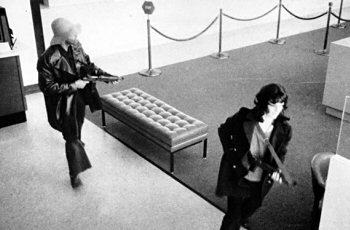In 1972, Regency Press published a novel called Black Abductor by Harrison James, the pseudonym for James Rusk Jr. The story centered around a terrorist group led by a black man who kidnapped a college student named Patricia. Her father was wealthy, well known, and had right wing sympathies.
In the novel, Patricia was kidnapped near her campus and her boyfriend, who was with her at the time, was badly beaten by the abductors. For a time, he was even a suspect in the case.
The fictional Patricia initially resisted her captors but soon subscribed to their ideology and become a champion of their cause. The terrorists send Polaroid photos to her father and describe what they’d done as America’s “first political kidnapping.” They predicted that they would eventually be surrounded by police, tear-gassed, and wiped out.
In 1974, two years after this book was written, Patricia Hearst – college student and daughter of wealthy, right-wing Randolph Hearst, was abducted from her apartment near her campus. Her kidnappers were members of the Simbionese Liberation Army, a terrorist group led by a black man. Her boyfriend, Steven Weed, was with her at the time, was badly beaten, and became a suspect in the case. Patricia Hearst, like the fictional Patricia, became a sympathizer of her abductors’ cause. She eventually robbed a bank with her abductors and was photographed carrying an M1 Carbine.
The FBI had apparently read the novel and the author became a suspect in the case. The real Patricia’s abductors were eventually surrounded by the police, tear-gassed, and killed, just as the fictional kidnappers had predicted they would be.
So, were the terrorists familiar with the novel? Or was this another instance where an author tunes in on a future event? We’ve written about this phenomenon before:
1) Parallels between the sinking of the Titanic and a fictional vessel, the Titan, depicted in Morgan Robertson’s novel Futility, written 14 years before the Titanic sank
2) The eerie connections between Edgar Allan Poe’s unfinished sea adventure novel and a real life event 48 years later
3) Author Nancy Pickard’s experience when a scene from one of her novels, Virgin of Small Plains, came true
4) Trish’s experience where her novel, Storm Surge, had eerie parallels to the devastating effects of Hurricane Andrew.
In 7 Secrets of Synchronicity, secret four is about the link between creativity and synchronicity. Perhaps in periods of heightened creativity, our consciousness, drifts free of the present, and soars through it, tapping into probable future events.









These things happen. Though, as it’s in a book, it sounds more impressive it’s probably no different to any ‘smaller’ synchro. Like when we say something, often without thinking, and sometimes it comes true – so why not when writers write. I see it as different degrees of synchronicity.
Different degrees of synchronicity: I like that!
I find it incredibly difficult to decide whether the idea came first and then they read the book… Although I have trouble imagining people like that reading… So it should be the first: the book?!?!?!
I have a feeling they didn’t read the book! Like you said, people like that probably don’t read!
The idea that they read the novel and decided, for the fun of it, they would reproduce the story in real life—even finding a Patricia on a college campus with a right wing family and predicting their own demise—all seems absurd. It was a synchronicity, like the Poe story, like the Robertson story, like Trish’s story.